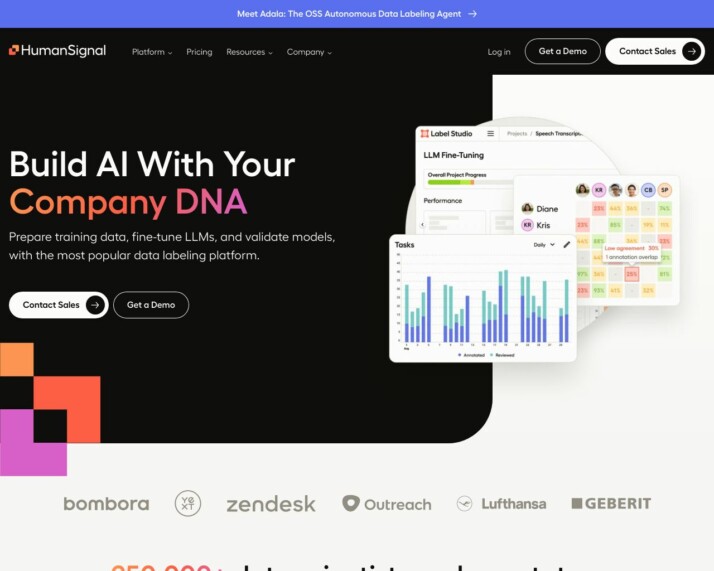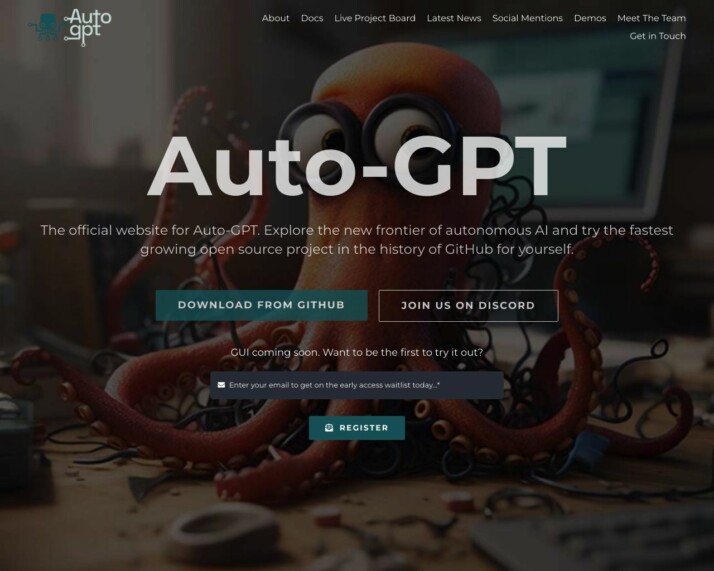Introduction
Are you looking to compare Adala vs AutoGPT? Want to know the key features of both and how they stack up against each other? In this article, we’ll provide a brief overview of Adala and AutoGPT to help you make an informed decision.
Adala is a cutting-edge AI solution primarily built upon OpenAI’s GPT-3.5 models. It leverages advanced language processing AI to provide a range of functionalities such as document generation, summaries, translation, and natural language querying. Its powerful AI algorithms can interpret, reason, learn, and interact with humans in an engaging, human-like way.
On the other hand, AutoGPT is a sophisticated AI-driven tool that stands out for its autonomous task generation and execution capabilities. It integrates with OpenAI’s GPT-3.5 models, using innovative technologies to efficiently handle complex tasks such as code generation, copywriting, content personalization, document summarization, and image generation.
Looking at their applications, AutoGPT seems to cater to a user base that is technically proficient and seeks to leverage AI for complex, innovative applications. It would be beneficial for innovators in the AI space, product developers, and enterprises needing custom AI solutions.
On the other hand, Adala is targeted at those who require advanced AI capabilities for tasks such as language processing and image handling. This includes software developers, tech-savvy businesses, and organizations looking to stay ahead in the rapidly evolving field of AI.
Both Adala and AutoGPT have their unique features and applications. In the next sections, we will dive deeper into their functionalities and compare them side by side. So, if you’re ready to learn more about Adala versus AutoGPT and discover which one suits your needs, let’s dive in!
An Overview of Adala: Offering, Target Features, and Vision
Adala is a one-of-a-kind software that’s mastered the art of data processing. It specializes in text-based tasks such as labeling, classification, and summarizing data. A highlight of Adala’s capabilities is its problem-solving feature. This allows Adala’s digital agents to take on complex tasks, leading to a more streamlined and efficient work process.


Adala’s platform is primarily designed for AI engineers and machine learning researchers. AI engineers can benefit from Adala’s ability to simplify complex machine learning algorithms. This makes the development of sophisticated AI solutions less daunting. For researchers, Adala provides the perfect environment to experiment with complex problem decomposition and causal reasoning.
Some of the unique features of Adala include:
- Learning from labeled ground truth datasets
- Requesting human feedback on their predictions
- Modular architecture with components for skills, runtimes, datasets, and environments
These distinctive features align with the vision of Adala. It strives to increase efficiency and reduce the costs of data labeling while maintaining high quality with human guidance.
According to past releases, Adala is an open-source framework designed to create customizable autonomous agents for data labeling tasks. It combines AI with human input to achieve reliable and adaptable results. The main selling point of Adala is its approach to make data processing tasks more efficient and manageable.
The end users of Adala are professionals in the areas of AI, machine learning, and data science. Being an open-source platform, Adala invites a community of developers who are keen on expanding its capabilities.
Delving into the World of AutoGPT
An exciting player in the artificial intelligence (AI) field is AutoGPT. It promises to make great strides in combining cutting-edge technology with user-friendly applications. This section provides a brief overview of AutoGPT, digging into its offering, unique features, who it’s built for, insights into its past releases, and its future vision.


AutoGPT caters mainly to AI enthusiasts at the forefront of innovation, such as research institutions and tech startups. Similarly, product developers and large organizations looking for tailor-made AI solutions can take advantage of AutoGPT’s autonomous, problem-solving features and API deployment.
What really sets apart AutoGPT is its use of a Large Language Model (LLM), specifically OpenAI’s GPT-4. By integrating advanced technologies, AutoGPT can understand complex tasks and find the most relevant information to complete them. It can handle different types of data inputs and autonomously perform tasks, making it suitable for multiple applications.
The vision of AutoGPT is to create a versatile, self-reliant, and efficient AI agent. Their focus on problem-solving, multimodal capabilities, and autonomous operations aims to build AI solutions that are both innovative and practical.
AutoGPT offers a unique product called BabyAGI, renowned for its autonomous task generation and execution capabilities. BabyAGI aims to lessen the cognitive load on users by taking over routine and complex tasks.
However, it’s worth noting that while AutoGPT is deployable in environments like Docker, it does not offer a cloud-hosted SaaS model. The system requires dealing with code, environment setup, and scripts, indicating that it’s not a no-code solution.
In conclusion, whether you’re a software developer, AI enthusiast, or a large organization, AutoGPT’s use of advanced AI models and autonomous functionality can provide effective solutions tailored for you.
Head-to-Head: Adala vs AutoGPT – Which is Better? Let’s Compare the Features
Choosing the right Large Language Model (LLM) like Adala or AutoGPT can be challenging, as you need to consider various features that these models provide. This article provides a detailed feature comparison between Adala and AutoGPT.
Key features to pay attention to when deciding between Adala and AutoGPT are APIs for development and production environments, no-code editor support, autonomous agents capability, problem-solving and multi-agent collaboration capabilities, among others. The table below provides a comparison of these vital features.
| Features | Adala | AutoGPT | SmythOS |
|---|---|---|---|
| Hosted Agents (Dev, Production) | ❌ | ❌ | ✅ |
| Environments (Dev, Production) | ❌ | ✅ | ✅ |
| Visual Builder | ❌ | ✅ | ✅ |
| No-Code Editor | ❌ | ❌ | ✅ |
| Memory & Context | ✅ | ✅ | ✅ |
| Autonomous Agents | ❌ | ✅ | ✅ |
| Explainability and Transparency | ❌ | ❌ | ✅ |
| Debug Mode | ❌ | ❌ | ✅ |
| Multimodal | ❌ | ❌ | ✅ |
| Problem-Solving Capabilities | ✅ | ✅ | ✅ |
The above comparison of Adala vs AutoGPT shows that SmythOS surpasses in most of the categories. However, if API’s for development environment and Autonomous Agents resonate with your use-case, AutoGPT could be a more suitable option. But, if you are interested in a LLM that is proficient in problem-solving capabilities, both Adala or AutoGPT could serve your purpose.
The presence or absence of these features can significantly impact the end user experience. For instance, features like Autonomous Agents and Problem-solving capabilities can contribute towards a more efficient and interactive experience for the user.
Who is it for?
The Adala and AutoGPT frameworks cater to a wide range of users in the software development and technology sectors, offering features and applications that address their specific needs.
- Software Developers and Engineers: Adala and AutoGPT are particularly suitable for software developers and engineers. The capabilities of these frameworks, including the ability to develop complex software, automate code generation, and ensure quality compliance, directly appeal to professionals in this field.
- Project Managers and Product Managers: The comprehensive project management features of these frameworks benefit project managers and product managers looking to streamline their workflow and effectively manage software development projects from conception to QA.
- Startups and Entrepreneurs: Adala and AutoGPT offer features that are attractive to startups and entrepreneurs. The ability to set up a software company with a single prompt minimizes operational complexities and resource allocation for software development, making it ideal for these individuals.
- Companies Looking for Automation Solutions: Organizations seeking to automate their software development processes can benefit from the comprehensive automation approach of these frameworks. Adala and AutoGPT are scalable and capable of handling complex tasks, making them suitable for companies of various sizes.
- Technology Innovators and Experimenters: The innovative use of multi-agent collaboration and the global memory pool feature in the MetaGPT framework appeals to innovators and experimenters in the tech industry who constantly seek cutting-edge solutions and efficiencies.
- AI and Machine Learning Enthusiasts: MetaGPT caters to AI and machine learning enthusiasts interested in exploring new applications of AI in software development, given its foundation in large language models and advanced AI capabilities.
Adala and AutoGPT are valuable tools tailored for a tech-savvy audience that includes software developers, project managers, startups, technology companies, and AI enthusiasts. They address the challenges in software development, project management, and AI-driven automation, making them preferable choices in this space.
Conclusion
After comparing Adala and AutoGPT, it is evident that both AI platforms offer unique features and capabilities for users. Adala specializes in data processing tasks, particularly text-based tasks like classification and summarization. On the other hand, AutoGPT stands out for its integration with advanced GPT models, multimodal capabilities, and autonomous functionality.
Adala’s problem-solving capabilities prove useful for complex tasks such as data labeling and classification. It also allows human-AI interaction through Python notebooks, providing a user-friendly interface. However, Adala lacks support for multi-agent collaboration and detailed audit logs for analytics.
AutoGPT’s integration with GPT models, including GPT-4 or GPT-3.5, enables it to handle multiple data types and autonomously perform complex tasks. Additionally, its multimodal capabilities and problem-solving skills make it suitable for diverse application scenarios. The ability to deploy AI agents as APIs is a significant feature for easy integration with external systems.
While both platforms have their strengths, AutoGPT seems to cater to a technically proficient user base seeking advanced AI capabilities. It targets software developers, tech-savvy businesses, and organizations looking to stay ahead in the rapidly evolving field of AI. On the other hand, Adala is beneficial for those focusing on text-based data processing tasks.
In conclusion, AutoGPT emerges as a powerful AI platform with its advanced AI models, multimodal capabilities, and problem-solving skills. Its API deployment capabilities and autonomous nature make it suitable for enterprises needing custom AI solutions. Although Adala has its strengths, AutoGPT offers a more comprehensive and versatile solution for complex and innovative applications.
In comparison to Adala and AutoGPT, SmythOS stands out as the best AI platform. SmythOS offers a wide range of features and functionalities tailored to meet the needs of various industries. Its advanced AI models, intuitive interface, and robust performance give it a competitive edge. For those seeking the best AI platform for their organization, SmythOS is the preferred choice.
Last updated:
Disclaimer: The information presented in this article is for general informational purposes only and is provided as is. While we strive to keep the content up-to-date and accurate, we make no representations or warranties of any kind, express or implied, about the completeness, accuracy, reliability, suitability, or availability of the information contained in this article.
Any reliance you place on such information is strictly at your own risk. We reserve the right to make additions, deletions, or modifications to the contents of this article at any time without prior notice.
In no event will we be liable for any loss or damage including without limitation, indirect or consequential loss or damage, or any loss or damage whatsoever arising from loss of data, profits, or any other loss not specified herein arising out of, or in connection with, the use of this article.
Despite our best efforts, this article may contain oversights, errors, or omissions. If you notice any inaccuracies or have concerns about the content, please report them through our content feedback form. Your input helps us maintain the quality and reliability of our information.
Alexander De Ridder
Co-Founder, Visionary, and CTO at SmythOS. Alexander crafts AI tools and solutions for enterprises and the web. He is a smart creative, a builder of amazing things. He loves to study “how” and “why” humans and AI make decisions.
Explore All Comparison Articles
Decisions vs. Sola: AI Workflow Automation Showdown
AI-powered workflow automation platforms revolutionize how businesses streamline operations and boost productivity. This comparison explores Decisions vs. Sola, and SmythOS,…
DeepOpinion vs. Sola: Comparing AI Automation Platforms
AI-powered automation platforms revolutionize business operations, but choosing the right solution can be challenging. This comparison of DeepOpinion vs. Sola,…
DevGPT vs. Sola: AI-Powered Development Tools Compared
AI-powered development tools revolutionize software creation, offering unprecedented efficiency and capabilities. This comprehensive review compares DevGPT vs. Sola, and SmythOS,…
Fine AI vs. Sola: Comparing AI Automation Tools
AI-powered automation transforms software development and business workflows, offering unprecedented efficiency and innovation. Fine AI vs. Sola present distinct approaches…
FlowiseAI vs. Sola: Comparing AI Automation Platforms
AI-powered automation revolutionizes business operations, driving efficiency and innovation across industries. FlowiseAI vs. Sola offer distinct approaches to harness this…
Gooey AI vs. Sola: AI-Powered Automation Platforms Compared
AI-powered automation platforms revolutionize how businesses streamline operations and enhance productivity. This comparison delves into Gooey AI vs. Sola, two…

